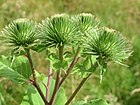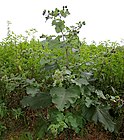Note: This is a project under development. The articles on this wiki are just being initiated and broadly incomplete. You can Help creating new pages.
Difference between revisions of "Arctium Lappa - Jangli Kuth"
(→Chemical Composition) |
(→References) |
||
| Line 73: | Line 73: | ||
<references> | <references> | ||
| − | <ref name="chemical composition">[ | + | <ref name="chemical composition">[http://gbpihedenvis.nic.in/PDFs/Glossary_Medicinal_Plants_Springer.pdf Pharmacology]</ref> |
<ref name="Leaf">[http://www.luontoportti.com/suomi/en/kukkakasvit/greater-burdock Morphology]</ref> | <ref name="Leaf">[http://www.luontoportti.com/suomi/en/kukkakasvit/greater-burdock Morphology]</ref> | ||
Revision as of 09:35, 24 June 2019
Arctium is a genus of biennial plants commonly known as burdock, family Asteraceae. Native to the Old World, several species have been widely introduced worldwide.
Contents
- 1 Uses
- 2 Parts Used
- 3 Chemical Composition
- 4 Common names
- 5 Properties
- 6 Habit
- 7 Identification
- 8 List of Ayurvedic medicine in which the herb is used
- 9 Where to get the saplings
- 10 Mode of Propagation
- 11 How to plant/cultivate
- 12 Commonly seen growing in areas
- 13 Photo Gallery
- 14 References
- 15 External Links
Uses
Fever, Cold, Cancer, Anorexia, Nervosa, Blotches, Gastrointestinal disorder, Joint pain, Bladder infections, Complications of syphilis, Acne and psoriasis.
Parts Used
Dried Root, Leaves, Stem, Seed.
Chemical Composition
Important constituents of Burdock roots are fatty acids, organic acids, phenolic acids, lignans, sesquiterpenes, tannin, inulin and mucilage. [1]
Common names
| Language | Common name |
|---|---|
| Kannada | |
| Hindi | |
| Malayalam | |
| Tamil | |
| Telugu | |
| Marathi | NA |
| Gujarathi | NA |
| Punjabi | NA |
| Kashmiri | NA |
| Sanskrit | |
| English | Greater Burdock, Bardana |
Properties
Reference: Dravya - Substance, Rasa - Taste, Guna - Qualities, Veerya - Potency, Vipaka - Post-digesion effect, Karma - Pharmacological activity, Prabhava - Therepeutics.
Dravya
Rasa
Guna
Veerya
Vipaka
Karma
Prabhava
Habit
Identification
Leaf
| Kind | Shape | Feature |
|---|---|---|
| Simple | Alternate | Blade triangular–broadly ovate, usually cordate based, with toothed margins, underside white-grey-cottony |
Flower
| Type | Size | Color and composition | Stamen | More information |
|---|---|---|---|---|
| Unisexual | 3.5–4 cm | Yellow | 5-20 | Flowers are wide, single flower-like capitula surrounded by involucral bracts |
Fruit
| Type | Size | Mass | Appearance | Seeds | More information |
|---|---|---|---|---|---|
| Flattish | 7–10 mm (0.28–0.4 in.) long pome | Dark-spotted achene with short yellow hooked hairs on tip | grey-brown | many | {{{6}}} |
Other features
List of Ayurvedic medicine in which the herb is used
- Vishatinduka Taila as root juice extract
Where to get the saplings
Mode of Propagation
How to plant/cultivate
Succeeds in most soils when grown in partial shade. Prefers a moist neutral to alkaline soil[3]
Commonly seen growing in areas
Waste ground, Preferring calcareous soils, Meadows and woods.
Photo Gallery
References
External Links
- Ayurvedic Herbs known to be helpful to treat Fever
- Ayurvedic Herbs known to be helpful to treat Cold
- Ayurvedic Herbs known to be helpful to treat Cancer
- Ayurvedic Herbs known to be helpful to treat Anorexia
- Ayurvedic Herbs known to be helpful to treat Nervosa
- Ayurvedic Herbs known to be helpful to treat Blotches
- Ayurvedic Herbs known to be helpful to treat Gastrointestinal disorder
- Ayurvedic Herbs known to be helpful to treat Joint pain
- Ayurvedic Herbs known to be helpful to treat Bladder infections
- Ayurvedic Herbs known to be helpful to treat Complications of syphilis
- Ayurvedic Herbs known to be helpful to treat Acne and psoriasis
- Herbs with Dried Root used in medicine
- Herbs with Leaves used in medicine
- Herbs with Stem used in medicine
- Herbs with Seed used in medicine
- Herbs with common name in English
- Habit - Herb
- Index of Plants which can be propagated by Seeds
- Index of Plants which can be propagated by Cuttings
- Herbs that are commonly seen in the region of Waste ground
- Herbs that are commonly seen in the region of Preferring calcareous soils
- Herbs that are commonly seen in the region of Meadows and woods
- Herbs
- Asteraceae








